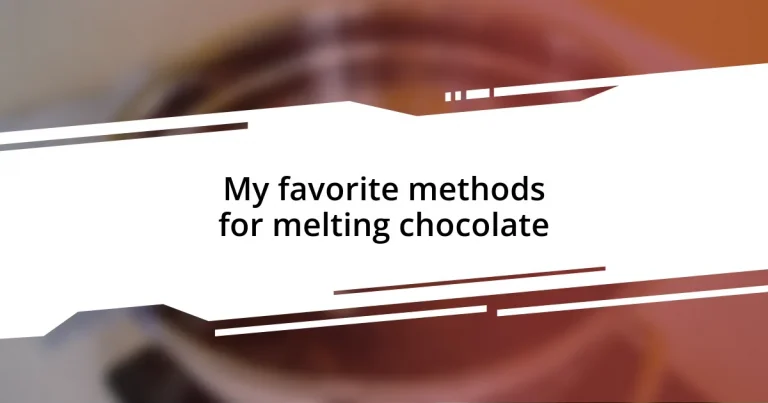Key takeaways:
- Melting chocolate requires technique and patience, as using the right methods can prevent burning and enhance the final product.
- Quality chocolate significantly affects both taste and texture, leading to a more enjoyable baking experience.
- Essential tools for melting chocolate include a double boiler, microwave-safe bowl, silicone spatula, and chocolate melting pot, each aiding in achieving smooth results.
- Preventing chocolate from seizing involves maintaining a dry workspace, avoiding distractions, and melting chocolate gradually to achieve a silky texture.
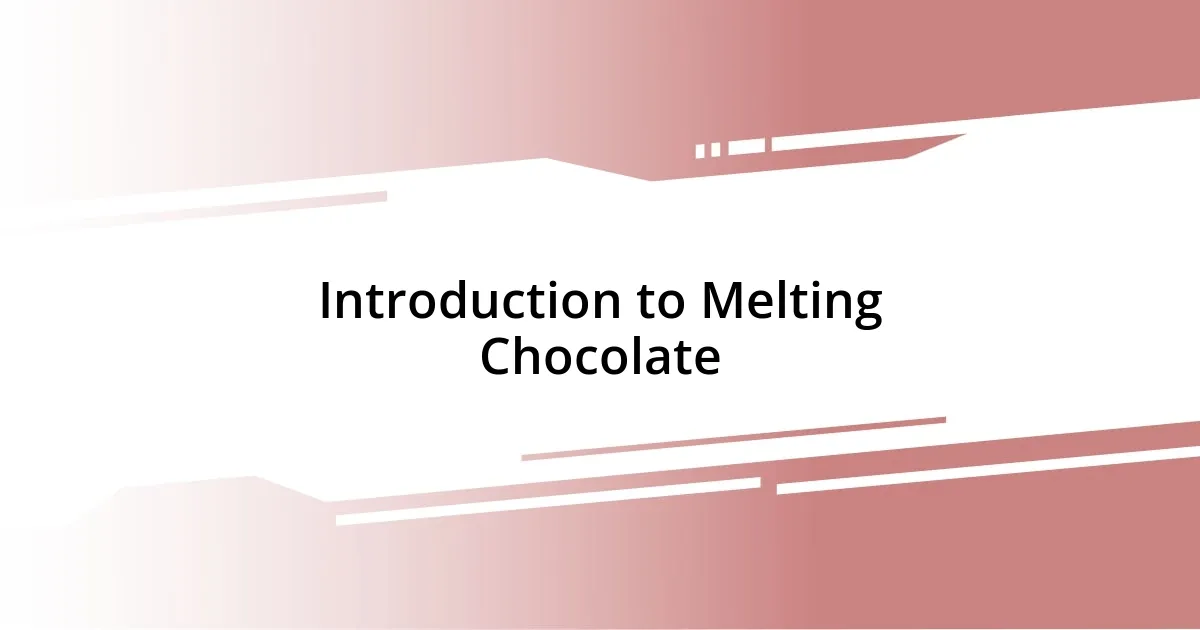
Introduction to Melting Chocolate
Melting chocolate might seem like a simple task, but there’s an art to it that can elevate your culinary creations. Picture this: the moment you see that glossy, rich chocolate begin to transform as it melts, it’s like a small miracle in your kitchen. Have you ever stood over a bowl of chocolate, waiting with bated breath for it to perfectly soften? I know I have. That feeling of anticipation is part of what makes melting chocolate so satisfying.
There are a few methods for melting chocolate, each with its own pros and cons, and I’ve tried them all. I remember my first time using a double boiler – it felt a bit intimidating. However, as I watched the chocolate gradually turn into a smooth, silky sauce, my doubts melted away, just like that chocolate. Isn’t it interesting how such a simple technique can impact your final dish?
Whether you’re dipping strawberries or making a luscious ganache, knowing how to melt chocolate properly is crucial. Getting it just right can make all the difference in your baking endeavors. Have you ever tasted burnt chocolate? I certainly have, and trust me, there’s nothing more disheartening. My journey through the melting process has taught me that patience and the right technique are key to achieving chocolate perfection.
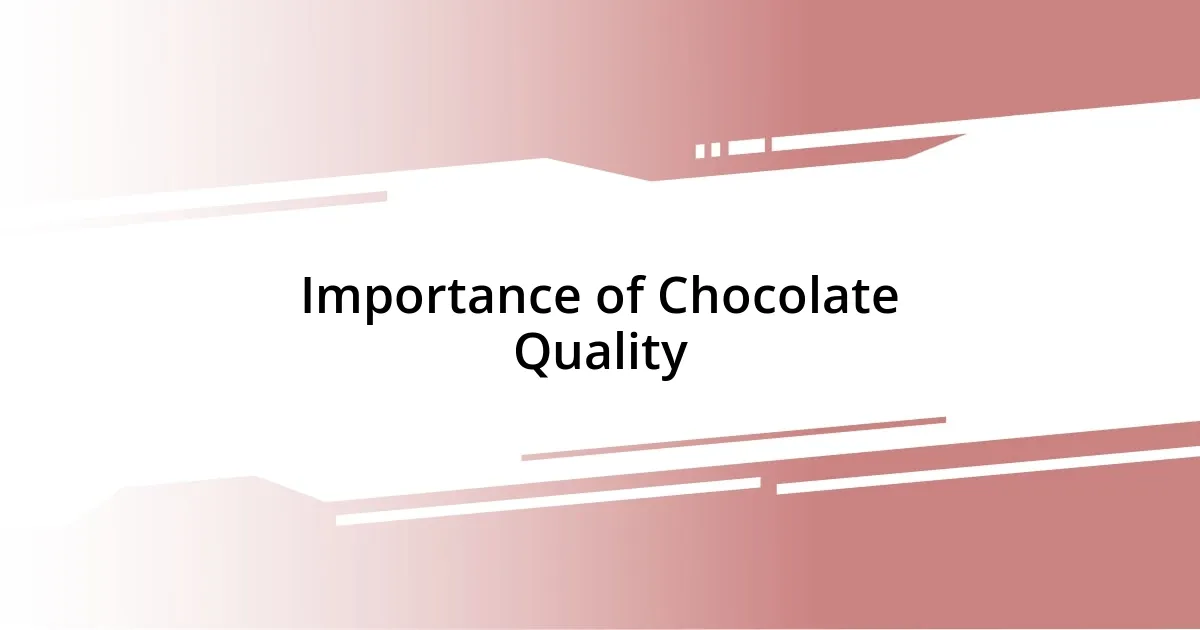
Importance of Chocolate Quality
When it comes to chocolate, quality is paramount. I’ve often found that using high-quality chocolate transforms the taste of whatever I’m making. Remember that time I used an inexpensive brand for a chocolate mousse? The flavor was flat and left me feeling disappointed. Quality chocolate brings a depth of flavor and a smoothness that can elevate any dessert.
Not all chocolate is created equal, and it really shows when melting. My first attempt with low-quality chocolate resulted in a clumpy mess, and I felt like I was fighting a losing battle. Quality chocolate melts evenly, creating that rich, glossy finish that makes desserts look as good as they taste. In my experience, it truly pays to invest in a decent chocolate product, especially for special occasions or significant events.
Many people underestimate how the quality of chocolate affects both texture and taste after it’s melted. I remember being blown away by the difference when I tried a premium dark chocolate; the flavor truly danced on my palate. The result was a luscious sauce that begged to be drizzled over everything. Whether you’re making truffles or a simple chocolate dip, using a higher quality chocolate enhances not only the end product but also your overall baking experience.
| Chocolate Quality | Experience |
|---|---|
| High Quality | Rich flavor, smooth texture, more enjoyment in melting |
| Low Quality | Flat taste, uneven melting, disappointing results |
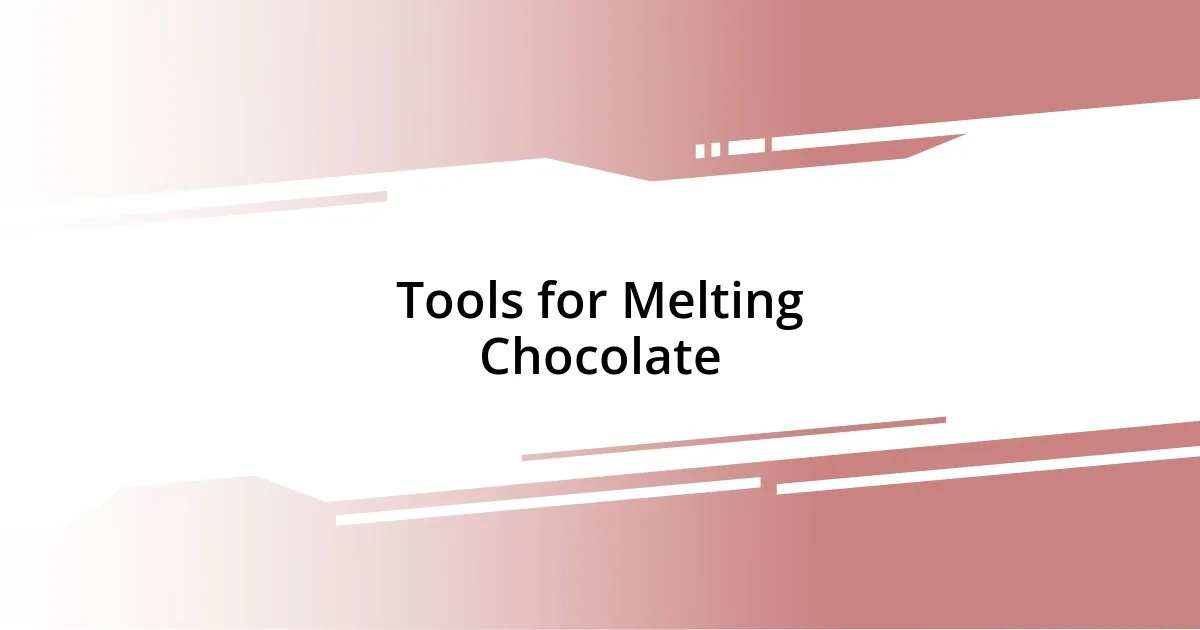
Tools for Melting Chocolate
When it comes to melting chocolate, having the right tools can make a significant difference. I’ve gathered a few essentials over the years that have simplified the process for me. There’s something comforting about having the right equipment at hand, knowing it will lead to that perfect outcome. From my experience, using the right tools not only saves time but also gives me confidence that I won’t mess things up.
Here are some indispensable tools for melting chocolate:
- Double Boiler: This classic method provides gentle heat, ensuring smooth melting without burning. I fondly recall the first time I used my grandmother’s old double boiler; it felt like using a treasured family heirloom.
- Microwave-Safe Bowl: A quick way to melt chocolate when you’re short on time. Just be sure to stir and monitor it closely, as I learned the hard way after a few charred chocolate chunks!
- Silicone Spatula: Essential for scraping every last bit of chocolate from the bowl. My trusty spatula has seen countless melted chocolate sessions, each one bringing a small wave of nostalgia.
- Chocolate Melting Pot: For serious chocolate enthusiasts, this gadget melts chocolate evenly and keeps it warm. I splurged on one last year, and it has quickly become my favorite kitchen companion during baking marathons.
Having these tools on hand not only streamlines the melting process but also enhances the overall experience—transforming what could be a stressful task into something enjoyable.
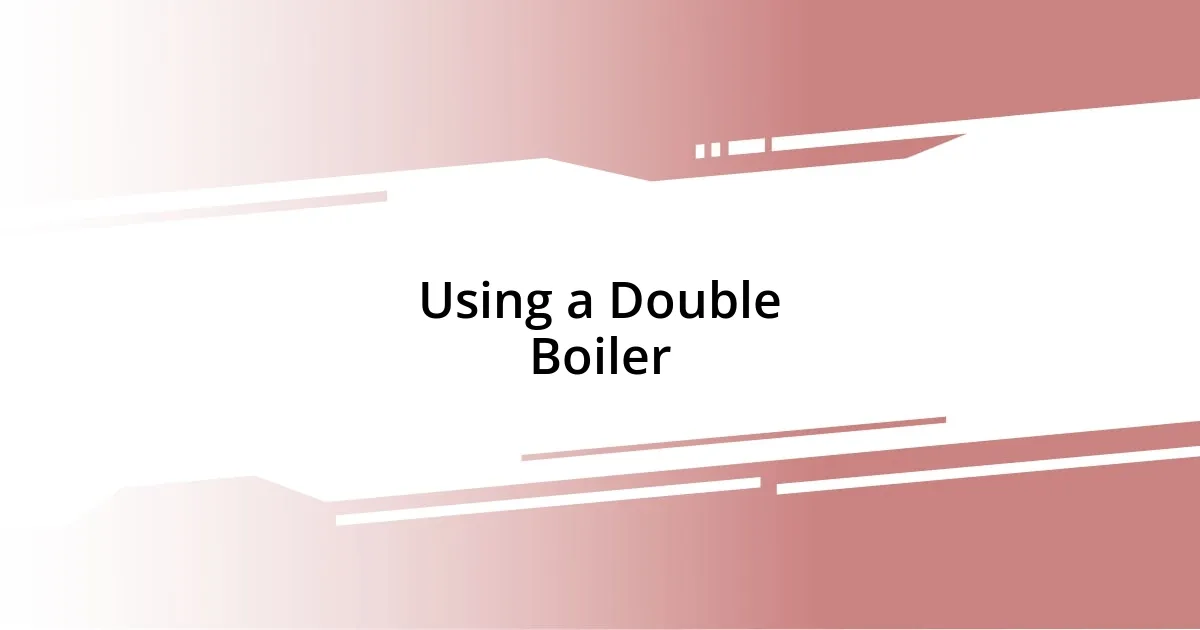
Using a Double Boiler
Using a double boiler is my go-to method for melting chocolate, and there’s a good reason for that. This technique allows the chocolate to melt gently without direct heat, which means I can avoid the dreaded burnt bits that ruin everything. I still remember the first time I came across a double boiler at a friend’s kitchen; I was amazed at how effortlessly it melted chocolate into a silky smooth liquid, while protecting it from overheating.
What I love about the double boiler is how you have complete control over the process. I often find myself checking the chocolate every few minutes, giving it a gentle stir. There’s something meditative about watching it transform from solid to liquid—such a satisfying moment! Have you ever felt the tension disappear as the rich, glossy chocolate starts to form? It’s totally unlike the microwave method, where one quick distraction can lead to disaster.
It’s also a great excuse to pull out my vintage cookware. I have a delicate double boiler that once belonged to my mother, and using it always brings a smile to my face. The nostalgia of making decisions about which pot fits better brings a certain warmth to the task, enhancing the experience. If you have a double boiler hiding in your kitchen, I highly recommend giving it a try for melting chocolate; you’ll enjoy the journey just as much as the final product!
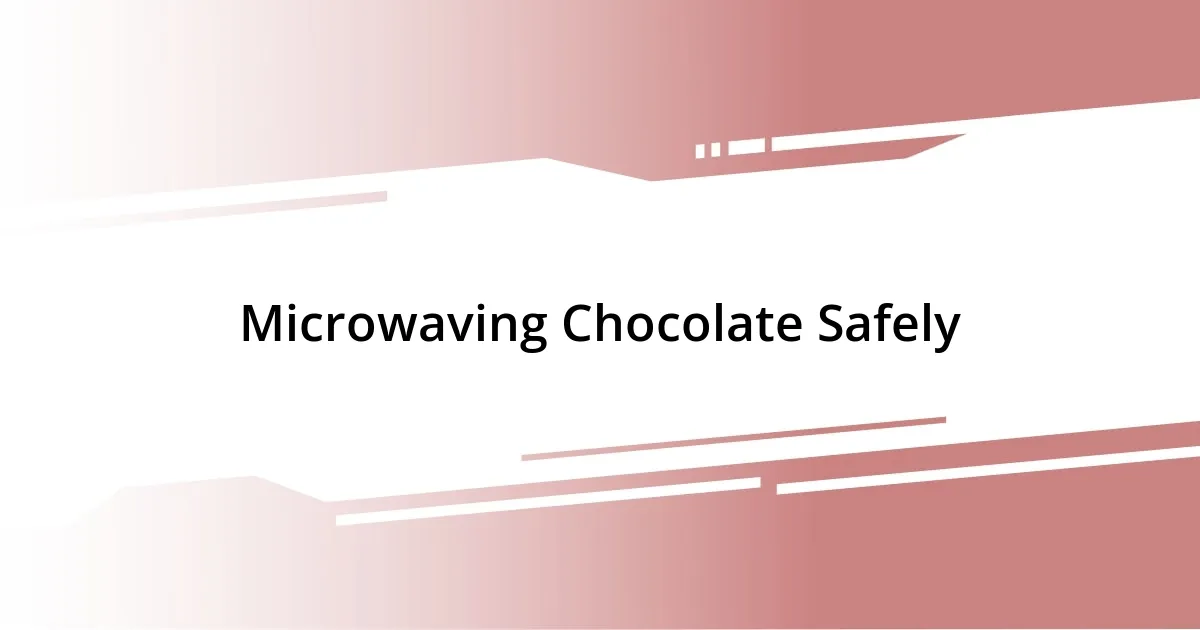
Microwaving Chocolate Safely
Microwaving chocolate safely requires a careful approach to prevent disasters. I remember the first time I decided to melt chocolate in the microwave—I was convinced it would be a breeze. I set the timer and walked away, only to return to a sad, burnt concoction that smelled awful. Now, I know to melt chocolate in short bursts, typically about 20 to 30 seconds, stirring in between. It’s like giving the chocolate a little love; this way, I can keep a close eye on its transformation without the fear of ruining it.
While using the microwave, I always opt for a glass or ceramic bowl. The last thing I want is plastic that could warp or release harmful chemicals into my chocolate. Plus, watching the chocolate slowly melt and become glossy is utterly mesmerizing! Have you ever felt that moment when you realize everything is coming together perfectly? The key is to embrace the routine of pausing and stirring—it almost feels like a culinary dance!
Another important tip is to avoid heating chocolate directly from the fridge. I learned this the hard way when my cold chocolate clumped up instead of melting smoothly. Now, I always try to let it sit out for a bit before microwaving it. It’s those little adjustments that elevate the experience, making the process more enjoyable and rewarding. With just a touch of patience and awareness, you can achieve that beautiful, melted chocolate that brings sweet joy to any recipe!

Tips for Preventing Seizing
When it comes to preventing chocolate from seizing, I’ve found that the little things really make a difference. I remember a moment where I mistakenly let a drop of water fall into my melting chocolate—just one drop! The way it clumped together was almost heartbreaking. From that day on, I became a stickler for ensuring my workspace is completely dry. It’s a simple step, yet it can save you from that frustrating moment of seized chocolate.
I also believe in the power of patience. Rushing the melting process can lead to disaster. There was a time when I tried to melt chocolate too quickly, and the outcome was gritty rather than smooth. Now, I take my time, allowing the chocolate to melt gradually, whether in a double boiler or the microwave. Have you ever frustrated yourself by wanting instant results? Trust me, chocolate deserves that extra care.
Lastly, I’ve learned to keep an eye on my surroundings. If I’m indulging in some chocolate melting, I also make sure there are no distractions. I’ve laughed at myself trying to multitask—who am I kidding? Chocolate melting demands your full attention! So next time you crank up that microwave or hover over a double boiler, ask yourself: “Am I really focused on this?” Doing so can make all the difference in achieving that luscious, smooth texture we all crave.
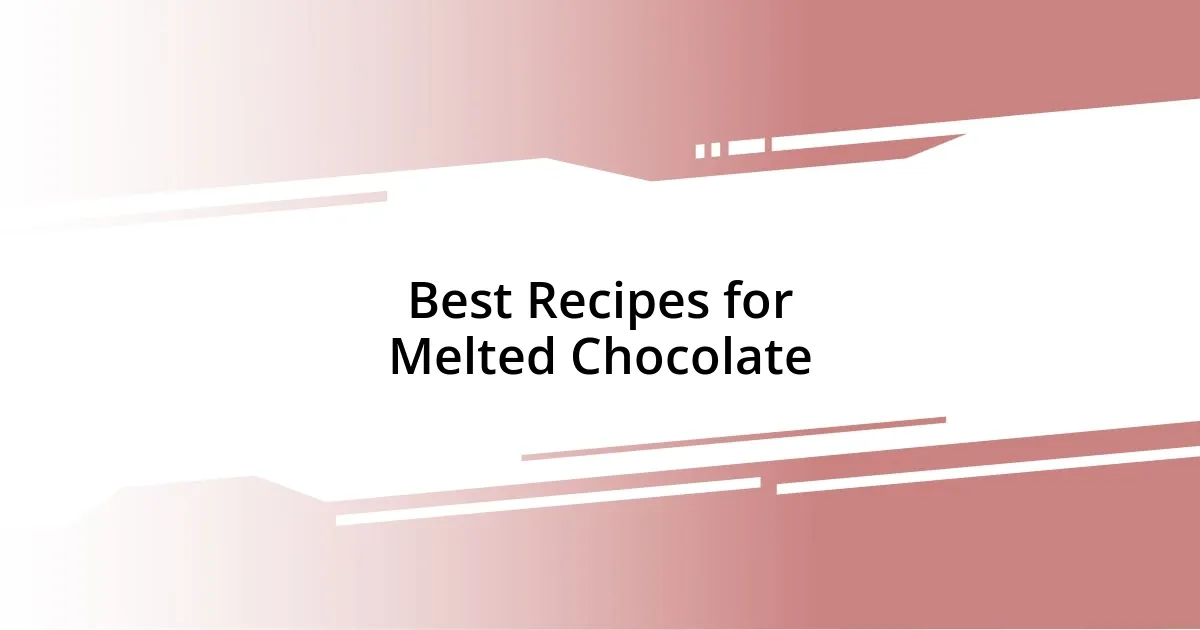
Best Recipes for Melted Chocolate
When it comes to delectable melted chocolate, my absolute favorite recipe is for chocolate-dipped strawberries. The contrast between the cool fruit and the warm, silky chocolate creates a little moment of bliss. I remember the first time I served them at a gathering; watching my friends’ faces light up was priceless. It’s as simple as melting chocolate in the microwave, then dipping fresh strawberries, and maybe sprinkling some crushed nuts on top. Have you ever experienced that rush of joy when something so easy can make such an impact?
Another recipe that never fails me involves making homemade hot chocolate. There’s something comforting about sipping a warm mug when the weather gets chilly. I like to melt a good-quality chocolate bar with a splash of milk in a saucepan and stir it until it’s perfectly creamy. One cold evening, I invited friends over for a cozy movie night and served this rich hot chocolate topped with whipped cream. The way everyone savored that first sip was a heartwarming reminder of how melted chocolate brings people together. What do you think makes hot chocolate such a nostalgic treat?
For a fun twist, I often create chocolate bark by melting chocolate and folding in nuts, dried fruits, or pretzels before spreading it out on parchment paper. I distinctly recall the first time I showcased this at a potluck—everyone was amazed at how something so easy could taste so extravagant! By breaking it into irregular pieces, I found that people loved grabbing handfuls to snack on throughout the evening. Have you tried making your own variation? It’s a fantastic way to get creative in the kitchen while melting chocolate!












